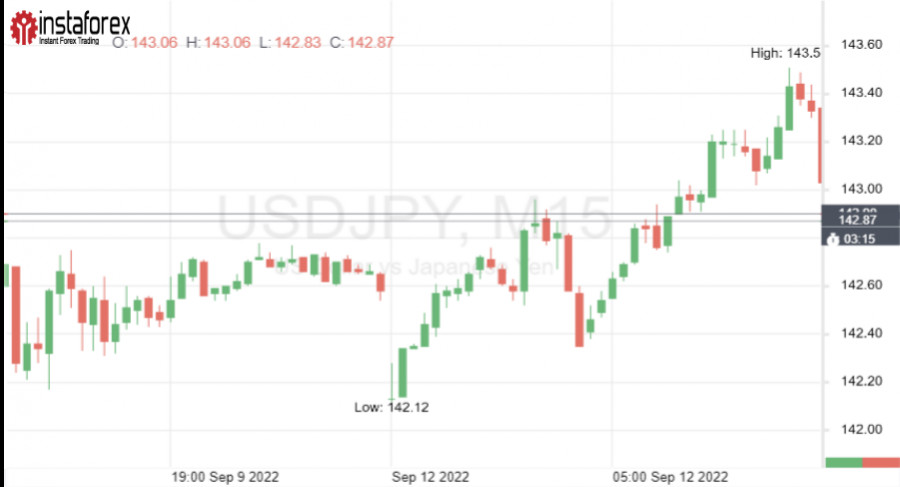Veja também


 12.09.2022 09:25 AM
12.09.2022 09:25 AMAfter Friday's fall, the dollar-yen pair finds the strength to rush upward. The asset demonstrates a confident upward trend at the beginning of the week, despite the predominance of negative factors.
Recall that last Friday the USD/JPY pair underwent intense sales. The quote fell by more than 1%, being under pressure from the growing risk of foreign exchange intervention.
The Japanese authorities significantly tightened their warning of their intervention after the yen came close to a new 24-year low of 145 in the middle of the week.
Many analysts believe that this key threshold is a red line for the Japanese government. As soon as the yen crosses it, officials will move from words to deeds.
Over the weekend, the risk of actual rather than verbal intervention increased significantly. On Sunday, Deputy Cabinet Secretary General Seiji Kihara said the authorities were deeply concerned about the excessive fall in the yen.
According to him, in the near future the government should take a number of measures in order to stop the depreciation of the national currency.
At the same time, Kihara refused to give any comments on the country's monetary and credit rate. This once again confirms that at this stage, Japanese politicians are not considering the possibility of helping the yen by raising interest rates.
The only option now being discussed at the top echelon is foreign exchange intervention. But will it bring the desired result if it is one-sided?
– For intervention to be effective, support from the Federal Reserve and other central banks is needed. However, right now, as major central banks fight inflation with policy tightening, global official support for the yen looks unlikely, said National Australia Bank currency strategist Rodrigo Catril.
The expert is confident that the yen will stop falling only as a result of a change in the exchange rate of the Bank of Japan.
To strengthen the currency, the central bank must abandon its ultra-soft policy and start raising the rate. Otherwise, the yen is waiting for a further collapse.
With no signs of BOJ capitulation on the horizon right now, the market has no choice but to ignore yet another warning of FX intervention.
Traders are well aware that even in the event of an actual intervention, the recovery of the yen will be very short-lived, so they resume long positions on the USD/JPY pair again.
The asset returned to the area above 143 on Monday morning.
Even the news that Japan intends to further weaken border controls when entering the country did not prevent its rise.
According to the Nikkei newspaper, the Japanese government may lift all current restrictions on foreign nationals entering the country by October.
The authorities hope that the rise in inbound tourism will help revive the fragile Japanese economy and thereby support the yen that has fallen heavily this year.
Another negative factor that the USD/JPY pair stubbornly turns a blind eye to this morning is tomorrow's release of US inflation statistics for August.
According to forecasts, the consumer price index on an annualized basis will decrease to 8.1% from the previous value of 8.5%.
It would be quite logical to expect that the weakening of inflationary pressure for the second consecutive month will force the Fed to reduce the degree of aggressiveness in relation to interest rates.
Despite a possible decline in inflation, prices still remain well above the 2% target.
Based on this, the markets continue to believe that the US central bank will raise rates by 75 bps in September. The probability of such a step is now estimated at 85%.
Traders' unwavering confidence in the Fed's determination is a key driver for the dollar, especially against the Japanese yen.
Most analysts believe that the USD/JPY asset could again demonstrate an impressive rally in the coming days, as moment X is just around the corner.
The US central bank's meeting on monetary policy issues, at which the decision on interest rates will be announced, will be held on September 20-21.
As the event approaches, hawkish expectations about the Fed's course should intensify even more. This will push the dollar to new heights, and the yen - to the next anti-records.
You have already liked this post today
*A análise de mercado aqui postada destina-se a aumentar o seu conhecimento, mas não dar instruções para fazer uma negociação.
S&P 500 atinge nova máxima histórica, mas resistência em 5.669 permanece como principal obstáculo. Suspensão temporária de tarifas impulsiona os ganhos: S&P 500 e Nasdaq encerram o dia em alta
A principal criptomoeda segue em um estado instável, sem conseguir estabelecer uma base sólida. O Bitcoin enfrenta alta volatilidade e registrou perdas nesta semana. Ainda assim, especialistas permanecem otimistas, prevendo
Tarifas de Trump sobre a China geram temores de recessão Os títulos do Tesouro dos EUA e o dólar são atingidos pela liquidação, e os rendimentos sobem Ações europeias caem
A mais recente rodada de tarifas impostas pelo governo Trump está reformulando as expectativas econômicas. O Goldman Sachs agora projeta uma recessão nos próximos 12 meses, enquanto analistas do JPMorgan
InstaForex em números

Your IP address shows that you are currently located in the USA. If you are a resident of the United States, you are prohibited from using the services of InstaFintech Group including online trading, online transfers, deposit/withdrawal of funds, etc.
If you think you are seeing this message by mistake and your location is not the US, kindly proceed to the website. Otherwise, you must leave the website in order to comply with government restrictions.
Why does your IP address show your location as the USA?
Please confirm whether you are a US resident or not by clicking the relevant button below. If you choose the wrong option, being a US resident, you will not be able to open an account with InstaTrade anyway.
We are sorry for any inconvenience caused by this message.


